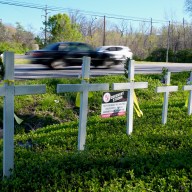YOSEMITE NATIONAL PARK, Calif. – There was a time not long ago when a climb to the top of Yosemite National Park’s Half Dome was a solitary trek attempted by only the most daring adventurers.
Over the past decade, however, the route has been inundated with up to 1,200 nature lovers a day seeking to experience the iconic mountain that is stamped on the California quarter, stitched on a line of outdoor clothing and painted on the side of the park’s vehicles.
Now officials want to permanently limit access to the granite monolith, frustrating both hikers who journey there for a transcendent experience and advocates who say the plan doesn’t go far enough to protect a place in a federally designated wilderness area.
“At the end of the day, if the visitors and users of wilderness aren’t willing to make sacrifices to preserve the wilderness character of these areas, then we just won’t have wilderness. We’ll have some Disney-fied version of it,” said George Nickas, executive director of Wilderness Watch.
“If people want solitude in Yosemite, there’s another 12,000 square miles to do that,” counters hiker Pat Townsley, a Bay Area resident who has been to the top nine times.
This past week the park released its environmental assessment of options for the future of the Half Dome trail, which studies show is the busiest by far of any in the National Park’s designated wilderness areas. The aim is to improve safety on the Dome and make the trail to get there less crowded.
Options range from doing nothing to removing the cables that hikers use to pull themselves up the 45-degree final climb, rendering it inaccessible to all but experienced climbers.
Nickas calls them “handrails in the wilderness,” and says his agency might sue to have them removed if park officials don’t choose that option.
“There is often an attempt by agencies to make wilderness all things to all people, and they can’t do that and still be wilderness,” he said.
The park’s recommendation is something in between a complete ban and the free-flowing days of the past when hikers packed together on the cables like cars in rush hour traffic. It would allow 300 people a day past a check point two miles distant beginning in 2013.
“There’s some subjectivity to this decision,” said park spokesman Scott Gediman. “But we considered how wilderness is managed and personal interviews with people about their experience on the trail. Finding balance is something we have to do.”
In 1874 the slick dome that rises 5,000 feet above the valley floor was described as “perfectly inaccessible.” But in 1919 the Sierra Club installed the first cables along the 400-foot final ascent so that visitors without rock climbing experience could hoist themselves to the summit —the size of 17 football fields— to drink in stunning views of Little Yosemite Valley, El Capitan, endless Sierra and the Valley floor.
“Once you get up there it’s like ‘holy cow.’ It’s just one of those moments in your life when you go ‘wow’ and you question your existence and space and time and everything else,” said hiker Townsley, who thinks everyone should be allowed the experience.
There is no doubt that if the decision were made today, there would be no braided steel cables and stanchions drilled into Half Dome. Congress passed the Wilderness Act in 1964, and 20 years later designated 95 per cent of Yosemite, including Half Dome and the well-worn eight-mile trail leading to it, as land that should not be altered by the hand of man.
Over the decades the number of visitors to the park has steadily climbed, topping 4 million last year— in part because the park is an easy drive from Los Angeles and the Bay Area. And the idea of scaling Half Dome in a day as measure of personal fortitude also began to grow.
At least five people have died on the cables since 2006, nearly all with rain as a factor, officials say. Rangers want visitors to be able to descend the slick granite in 45 minutes if they have to escape the fast-forming storms that make footing precarious, and limiting numbers is the only way to do that, they say.
Last year park officials instituted a temporary 400-permit lottery for daily access, which is roughly from Memorial Day until the first snow in October.
“I think they’re doing a fine job, but I think they’ve got a hairball that they’re dealing with trying to come up with something that works,” said Rick Deutsch, who wrote the book “One Best Hike: Yosemite’s Half Dome.” He says 400 permits is a more workable number that accounts for no-shows.
The increase in visitors is a challenge to park officials who must balance access with the system’s mandate to protect resources for future generations. The park already has been struggling over whether to limit the number of cars allowed in the gates to protect the Merced River that cuts through the heart of Yosemite Valley and is federally protected as Wild and Scenic.
The chance for the public to weigh in on all of the options in the Half Dome Trail Stewardship Plan ends March 15.
“Climbing Half Dome is iconic and we understand that,” spokesman Gediman said. “But at the same time we’re having to preserve and protect the park for future generations and provide for a positive visitor experience, because the National Parks belong to the American people.”
——-
Follow Tracie Cone on Twitter: (at)TConeAP















